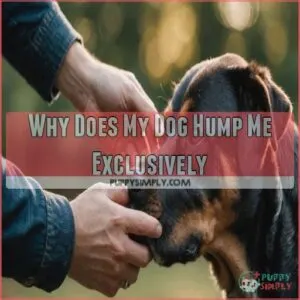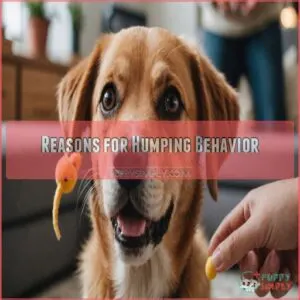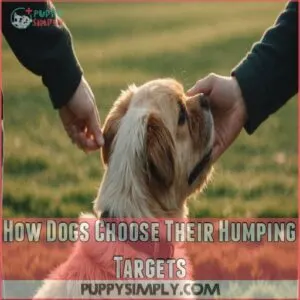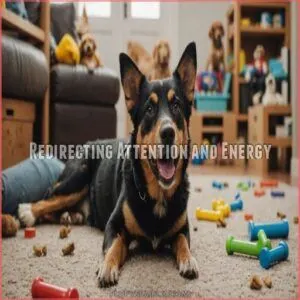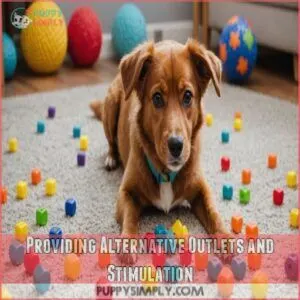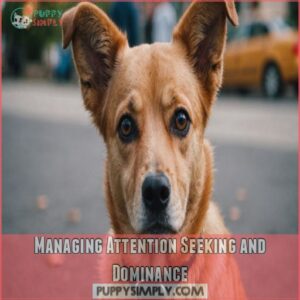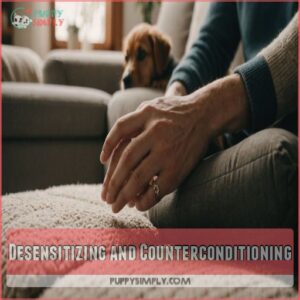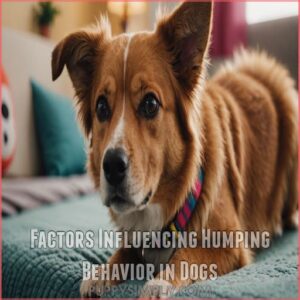This site is supported by our readers. We may earn a commission, at no cost to you, if you purchase through links.

Maybe they’ve marked you as their person, like you’ve got a sign saying “Best Human” without even realizing it. They might also feel safe and comfortable around you, letting loose with behavior they wouldn’t do elsewhere.
It’s not all about dominance; sometimes it’s just their way of interacting. Curious about how to manage this behavior effectively? There’s a lot more to unravel about this furry mystery.
Table Of Contents
- Key Takeaways
- Why Does My Dog Hump Me Exclusively
- Reasons for Humping Behavior
- How Dogs Choose Their Humping Targets
- Addressing Humping Behavior in Dogs
- Factors Influencing Humping Behavior in Dogs
- When to Seek Professional Help for Humping
- Frequently Asked Questions (FAQs)
- Why does my dog hump me?
- What causes humming or hissing in the ears?
- Can a dog hump you?
- Why does my dog Hump air uncontrollably?
- Can medical issues cause excessive humping in dogs?
- Why does my dog Hump after neutering?
- Why does my dog hump me but not my partner?
- Why does my dog hump one person only?
- Why is my dog desperate to hump me?
- Do dogs hump because of dominance?
- Does neutering always stop humping?
- My dog humps only my leg; why?
- Why does my dog hump my pillow?
- Is humping a sign of aggression?
- How can I stop humping permanently?
- Conclusion
Key Takeaways
- Your dog humps you because of the strong bond and comfort they feel around you, viewing you as their special person.
- It may also indicate attention-seeking behavior, where your dog uses humping to get your focus and affection.
- Humping can stem from excitement and the need to release energy, often seen as playful interaction rather than dominance.
- Consistent training, providing alternative outlets for energy, and clear boundaries can manage your dog’s humping behavior effectively.
Why Does My Dog Hump Me Exclusively
If you’re wondering why your dog seems to hump only you, it’s likely due to the strong bond and comfort they feel around you.
Their attachment and your reactions can reinforce this behavior, making it a unique interaction in your relationship.
Emotional Connection and Bonding
When your dog humps only you, it’s a sign of emotional bonding.
Your pet trusts you deeply, feeling love and attachment.
This behavior isn’t about dominance or stress; instead, it’s a quirky way they show affection.
While it might be awkward, it’s their way of connecting.
Think of it as a strange but real bond between you and your furry friend.
Sense of Comfort and Safety
Your dog’s humping might be less about dominance and more about feeling safe with you.
This behavior could mean your pet trusts you deeply and finds comfort and security in your presence.
Dogs often seek out those they’ve familiar bonds with, feeling relaxed and at ease.
While it can be awkward, remember it’s a sign of attachment and security.
Imprinting and Habituation
Besides seeking comfort, your dog’s habit of humping might come from imprinting and habituation.
Early socialization and puppy development play a role, creating bonding experiences and habit formation.
These behavioral patterns shape your dog’s actions, reflecting their unique attachment to you.
Understanding canine behavior, including imprinting and habituation, helps explain why your dog might choose you exclusively for this behavior.
Attention and Affection From Owner
Dogs often hump their owners because they’re seeking attention and affection, showing the deep owner-dog bond.
It might seem odd, but this humping as love is an attention-seeking behavior and an expression of affection.
Your reaction can influence this; positive reinforcement or ignoring the behavior shapes how often it happens.
Dogs simply crave the love you give.
Lack of Socialization With Other People
Has your dog only ever humped you?
A lack of socialization with other people might be a factor.
He might see you as his only safe, familiar person.
This isn’t necessarily bad, but it can lead to unusual behaviors like excessive humping.
Consider enrolling him in a socialization class or a playgroup.
This controlled exposure to new people can help him learn appropriate social skills, reducing his reliance on you for all his social needs.
Proper dog socialization is key!
Owner’s Reaction and Reinforcement
Your dog’s exclusive humping might be linked to your reactions.
If you react with mixed signals, like laughing one day and scolding the next, your pet gets confused.
This behavior might persist if it’s met with attention, even if it’s negative.
Positive reinforcement is the way to go, consistently rewarding calm behavior and avoiding accidental encouragement.
Reasons for Humping Behavior
In trying to understand why your dog humps, remember that it’s not always about romance.
This behavior can stem from factors like sexual drive, dominance, playfulness, or even boredom and stress.
Sexual Drive and Arousal
While pondering why your dog singles you out for humping, consider their sexual drive and arousal.
Hormonal changes during the heat cycle can skyrocket their urges.
Neutering or spaying might tone these down.
Age factors and breed differences further add to the mix.
Sometimes, a dog’s instincts just kick in, like a toddler crashing into your Zoom calls.
Dominance and Assertiveness
Exploring humping through the lens of dominance, consider how your dog’s trying to climb the social ladder with some assertive play.
They’re showing off their dog body language to proclaim their status.
Watching for dominance cues helps you understand their social standing within the pack hierarchy.
Some dogs may exhibit resource guarding behaviors, which can be misinterpreted as dominance. This behavior can seem like they’re calling the shots, but it’s natural dog social behavior.
Playfulness and Overexcitement
Moving from dominance, let’s chat about playfulness and how your dog’s overexcitement might fuel humping antics.
High energy breeds, especially during puppy play, show tons of dog excitement.
This excitement is a common reason why dogs hump their owners, as mentioned in the reasons for humping behavior.
Without a proper playtime routine, they might start humping you to redirect their energy.
Don’t stress! Channel that toy obsession into playtime and watch those behaviors settle down nicely.
Attention Seeking Behavior
Ever noticed your dog’s antics when it’s not playful excitement, but more like a frustrated dog wanting your eyes on them?
Your pup might be humping for attention-seeking behavior.
They’re practically begging, “Look at me!”
Address this with positive reinforcement.
Offer alternatives like dog belly rubs or toys to meet their other needs.
It’s not just dog submission; it’s a call for love.
Anxiety and Stress Relief
Sometimes, your dog’s humping isn’t about attention; it’s about stress relief.
Think of it as their way of self-soothing.
Anxiety can manifest in unusual ways.
If your pup’s humping seems linked to stressful situations, try calming exercises and stress-relieving activities.
A tired dog is a calmer dog, so make sure they get enough exercise.
Remember, anxiety management is key.
Consider relaxation techniques to help both you and your furry friend.
If it persists, chat with your vet.
Boredom and Lack of Stimulation
While anxiety might lead your dog to hump, boredom and lack of stimulation often play a part too.
Imagine your pup’s day without enough enrichment: they might turn to humping when they need engagement.
Spice things up with:
- Interactive toys to challenge their mind,
- A fun playtime schedule for bonding,
- Mental puzzles to satisfy curiosity and reduce hyperactivity.
How Dogs Choose Their Humping Targets
You might wonder why your furry friend picks you as their special humping target, leaving everyone else unbothered.
Dogs often choose people based on familiarity, comfort, and sometimes because they know they’ll get your instant attention or they smell other canine pals on you.
They Know They Can Get Away With It
You’ve probably noticed your dog’s persistence with humping.
It’s all about past behavior and your reaction.
Dogs quickly learn who lets them get away with stuff.
If your response is inconsistent or you reward their antics, they’ve learned it’s a free pass.
This highlights the emotional connection and bonding, but also the importance of setting clear boundaries to avoid rewarding bad habits.
They Want Your Attention
Craving some extra attention, your dog might resort to humping you.
It’s a quirky way to grab your focus, especially if previous antics haven’t worked.
This behavior can stem from attention-seeking or an emotional bond.
Your reaction matters—if you laugh or scold, even negative attention can inadvertently reinforce the habit.
Use positive reinforcement to guide better behavior.
They Are Hyper and Need to Release Energy
Excitement bubbles over like a fizzy drink, and your dog needs an outlet.
Hyperactivity often leads to humping to release energy.
To curb it, try these tips:
- Exercise with long walks.
- Add playtime with active toys.
- Introduce mental stimulation games.
- Prevent boredom with scheduled activities.
This can steer their playful antics toward more acceptable behaviors!
They Want to Play and Interact
After a burst of energy, your dog might see humping as a playful interaction, much like a child initiating a game of tag.
It’s not always about being inappropriate; it’s a mix of puppy behavior and reading social cues.
Dogs often use humping as a way to engage you, seeking playful interactions and socialization rather than dominance.
They Smell Other Dogs on You
Your dog’s playful intentions might shift.
Have you been to the dog park lately?
Dog scent lingers, especially on your clothes. That lingering smell might trigger your dog’s instinct to scent mark, even on you.
Think about your laundry habits. Washing clothes frequently can help minimize this.
It’s all about scent marking and your dog’s natural behaviors.
Remember, consistent training helps manage unwanted behaviors.
Addressing Humping Behavior in Dogs
When your dog humps you and not others, it can be embarrassing, but there are effective ways to manage it.
By redirecting their energy and providing consistent training and positive reinforcement, you can address this behavior and help your dog find healthier outlets.
Redirecting Attention and Energy
Ever wonder why your pup hones in on you for humping? It’s all about where their energy’s going.
Redirecting attention and energy can help.
You can also try utilizing products specifically designed for addressing dog humping issues.
Craft an exercise routine with engaging playtime ideas and interactive toys. This keeps them busy, providing mental stimulation and reducing attention-seeking behavior. Just like a busy mind can’t wander, a busy dog can’t hump.
Providing Alternative Outlets and Stimulation
Consider interactive toys to shift your dog’s energy away from humping and onto something fun.
Creative activities like puzzle feeders can engage their mind.
Durable chew toys, such as those recommended for strong-jawed breeds like Pointers who can chew on bones safely, are perfect for those with a knack for gnawing.
Think about these four options:
- Interactive toys
- Puzzle feeders
- Safe chew toys
- Enrichment activities
These can help cure that dog habit.
Consistent Training and Positive Reinforcement
Shifting from providing alternative outlets, consistent training can really tackle humping behavior.
Use reward-based training—consistency is key.
To avoid common mistakes, it’s important to understand the importance of avoiding harsh punishment.
Give effective commands and reward positive behavior.
Understand your dog’s attention-seeking ways and respond with positive reinforcement.
This approach strengthens your emotional connection and helps guide your dog to better habits.
Training isn’t magic, but with patience, improvement will come.
Managing Attention Seeking and Dominance
Tackling your dog’s humping habit involves understanding the dominance hierarchy and attention seeking behavior.
You’ll want to redirect this energy with positive reinforcement.
Consistent training is key, offering alternative outlets like toys or exercise.
Pay attention to your reaction; it might reinforce unwanted actions.
Stay patient and firm, ensuring your furry friend learns what’s acceptable and what’s not.
Desensitizing and Counterconditioning
So, you’ve addressed the attention-seeking aspect.
Now, let’s try desensitizing your dog.
Gradually expose them to situations that usually trigger humping, but prevent the behavior.
Use positive reinforcement – rewarding calm behavior.
This anxiety management technique, paired with consistent training, can help break the habit.
Remember, patience is key!
It’s all about building a stronger, happier bond.
Factors Influencing Humping Behavior in Dogs
Understanding why your dog humps you—and nobody else—can be linked to several factors, like their breed, age, and even medical conditions.
By looking at how your dog is raised and their environment, you might uncover clues about their unique behavior.
Breed and Temperament
Addressing humping involves understanding your dog’s breed and temperament.
Each breed has its quirks and genetic predispositions.
Some dogs might hump more due to their personality differences and behavioral patterns. You can find helpful solutions and products to address this behavior on a website that specializes in dog humping solutions.
Consider these influences:
- Breed-Specific Tendencies: Certain breeds are more active.
- Temperament Traits: Some dogs are more assertive.
- Emotional Connection: They may feel safe with you.
- Bonding and Comfort: Familiarity encourages humping.
Age and Developmental Stage
Puppies hump to explore new physical sensations, much like humans learning about their own bodies.
During adolescence, humping often peaks as dogs go through puberty.
Adult behavior may stabilize, but habits developed early can persist.
Senior dog humping can indicate changes in behavior due to discomfort.
Whether male or female, dog age and developmental stage greatly influence why they engage in humping.
Environmental Factors and Changes
Like kids adjusting to a new school, changes in your dog’s environment, such as a New Home or New Rules, can stir up their humping behavior, much like how they may exhibit separation anxiety or clinginess by lying on their owners.
Routine changes and stressors disrupt their comfort zone as much as ours, affecting their pack mentality and instinct to seek comfort and warmth.
Even shifts in Family Dynamics can affect their owner-dog relationship and dynamics, making your pet hanker for familiarity through this quirky habit.
Socialization and Training History
A playful puppy morphing into a confident companion hinges on the fact that certain breeds, such as Pointers, are highly trainable through positive reinforcement methods. early socialization and smart training.
If Fido’s zoomies include humping, it might trace back to gaps in puppy training.
Use consistent commands and positive reinforcement to guide behavior.
To address unwanted behaviors like humping, consider humane training methods outlined in top-rated dog training books best dog training books, which emphasize positive reinforcement techniques. Harness the power of leash training for dog behavior correction, whether you’re dealing with puppy antics or establishing dominance in older dogs.
Medical Conditions and Pain
Considering how past experiences shape behavior, you might notice that medical conditions can also trigger humping.
If your dog humps out of the blue, it could be their way of coping with discomfort or pain.
Think about potential allergies, urinary tract infections, or other issues.
Addressing these medical causes isn’t just discipline; it’s about understanding and caring for your furry friend.
When to Seek Professional Help for Humping
So, when should you call in the experts?
If your dog’s humping is aggressive, excessive, or just plain doesn’t stop despite your best efforts, it’s time to seek help from a vet or a professional dog trainer.
Aggression and Harsh Behavior
Aggression and harsh behavior in dogs can sometimes show up as humping.
If your dog starts growling or snapping during humping, it’s time to step in.
Look out for signs of aggression and consider consulting a professional.
While responsible ownership and proper training, such as early socialization and positive reinforcement techniques, play a crucial role in preventing aggression, managing aggression is essential for safety.
Remember, an emotional connection and sense of comfort shouldn’t lead to scary moments.
Excessive or Compulsive Humping
You’re not alone if your dog’s humping feels out of hand.
Beyond aggression, excessive or compulsive humping can leave you scratching your head.
It’s a behavior that pops up unexpectedly and can stem from anxiety triggers.
Don’t fret—help’s around the corner.
Consider:
- Compulsive humping when it interrupts daily life.
- Owner frustration grows with persistence.
- Treatment options focus on behavioral modification.
When needed, seek professional intervention.
Public Discomfort and Embarrassment
Finding yourself in a pickle when your dog decides to hump you at the park?
It’s more than just social awkwardness; it’s a dash of public shaming mixed with social anxiety.
If your dog’s humping behavior persists, consider seeking products and solutions specifically designed to address Humping behavior issues.
Dog humping etiquette involves understanding canine behavior, such as postures like the lazy dog sit, and knowing when to stop it.
If you’re dealing with stares and repeated issues, seeking professional help could be your best move.
Concerns About Dominance or Aggression
When your dog’s humping seems more like a dominance display or becomes aggressive, it’s time to get professional help.
Maybe they’re feeling overly bonded, or your reaction reinforced the behavior unknowingly.
Managing aggression and understanding the reasons why your dog humps you exclusively can help.
A trainer or vet can provide insights to reduce dog aggression effectively.
Persistent Problems and Frustration
Is your pup’s humping turning into a circus act that’s testing your patience?
Persistent problems and frustration could be hinting it’s time for professional help.
When dog training and gentle guidance fall flat, a vet or behaviorist might spot hidden issues.
Dogs often hump due to reasons like emotional connection, comfort, or just needing more attention and affection from you.
Frequently Asked Questions (FAQs)
Why does my dog hump me?
Your dog might hump you because it feels emotionally connected or seeks your attention.
It could also be a playful action or a sign of dominance.
If it bothers you, redirect your dog’s behavior gently.
What causes humming or hissing in the ears?
About 15% of people experience tinnitus, where you might hear humming or hissing in your ears.
It can be caused by loud noises, ear infections, or conditions like Meniere’s disease.
Consider seeing a doctor if it persists.
Can a dog hump you?
Of course, dogs can hump you.
They might do it for reasons like showing dominance, seeking attention, or just boredom.
It’s common behavior, so consider redirecting their energy with exercise or gentle discipline to manage it.
Why does my dog Hump air uncontrollably?
Seeing your dog hump air can seem puzzling, but it’s often linked to excitement or anxiety.
Encourage regular exercise to burn off energy.
If persistent, chat with a vet to rule out medical concerns.
Can medical issues cause excessive humping in dogs?
Yes, medical issues like urinary tract infections or hormonal imbalances can cause excessive humping in dogs.
If your pooch’s behavior seems odd or persistent, it’s smart to consult a vet to rule out health problems.
Why does my dog Hump after neutering?
Even after neutering, your dog might still hump. It could be habit, excitement, or even anxiety. Try redirecting him with toys or a walk. If it persists, consult a vet.
Why does my dog hump me but not my partner?
Your dog might hump you and not your partner due to the scent of other animals on your clothes, seeking attention, or having a strong emotional connection with you.
It can be about comfort, or even dominance.
Why does my dog hump one person only?
Imagine being the chosen one at a concert;
your dog humping only you could mean affection, dominance, or attention-seeking.
They might feel secure with you or know they can get away with it.
Why is my dog desperate to hump me?
Your dog may be desperate to hump you due to emotional attachment, attention-seeking, or dominance.
They feel safe and loved around you, leading to this behavior, which can be redirected with consistent training and boundaries.
Do dogs hump because of dominance?
Dogs, like tiny monarchs claiming their kingdom, might hump to show dominance.
It’s just one reason, joining a mix of others like playfulness or stress.
Remember, consistent training and attention can help manage this behavior.
Does neutering always stop humping?
Neutering can reduce humping in some dogs, but it doesn’t always stop it completely.
Factors like excitement, stress, or playfulness might still trigger the behavior.
Consistent training and plenty of exercise help manage this habit better.
My dog humps only my leg; why?
Your dog might see your leg as a comfortable, familiar target.
It could be attention-seeking, playful, or even a sign of stress.
Try redirecting the behavior with toys or a walk.
If it persists, consult a vet.
Why does my dog hump my pillow?
Pillow humping might be your dog’s way of dealing with boredom, stress, or seeking comfort.
It can also signal excess energy.
Consider offering more play, exercise, or comfort to address this quirky, yet natural behavior.
Is humping a sign of aggression?
Imagine humping as a quirky language your dog speaks.
It’s usually playful or attention-seeking, not aggression.
If it goes too far, like excessive or forceful humping, chat with a vet or trainer for guidance.
How can I stop humping permanently?
Training your dog to stop humping involves consistency.
Firmly redirect with commands, provide plenty of exercise, and make sure they’ve a healthy diet.
Consider neutering your pet, and consult a trainer if the behavior persists despite efforts.
Conclusion
Imagine this: your dog only humps you when you’re binge-watching your favorite show.
This quirky behavior might just be their way of claiming you as their own.
It’s not uncommon for dogs to hump due to changes in environment or emotions.
By understanding why your dog humps you and no one else, you can address it through training and providing alternative outlets.
If humping becomes excessive or a concern, consider seeking professional guidance for further help.

